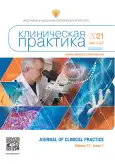A clinical case of a successful step-by-step treatment of a patient with a dissecting aneurysm of the ascending aorta involving the trunk of the left coronary artery
- Authors: Bocharov A.V.1, Popov L.V.2
-
Affiliations:
- Kostroma Regional Clinical Hospital named after Korolev E.I.
- National Medical and Surgical Center named after N.I. Pirogov
- Issue: Vol 12, No 1 (2021)
- Pages: 113-118
- Section: Case reports
- URL: https://journals.rcsi.science/clinpractice/article/view/62873
- DOI: https://doi.org/10.17816/clinpract62873
- ID: 62873
Cite item
Full Text
Abstract
Background: The presented clinical case shows a version of successful step-by-step medical care for a patient with a dissecting aneurysm of the ascending aorta involving the trunk of the left coronary artery in a vascular center without a cardiac surgical support. Clinical case description: The patient was admitted to the Kostroma Regional Vascular Center with the symptoms of Acute Coronary Syndrome. During the examination in the clinic, the diagnosis of acute coronary syndrome with ST segment elevation was confirmed, and a dissecting aneurysm of the ascending aorta was also revealed. According to emergency coronary angiography, the dissection of the left coronary artery trunk was visualized, and the left coronary artery trunk was successfully stented with a bare metal stent. Later, the patient was transferred to a federal center, where aortic prosthetic reconstruction was performed. Conclusion: In patients with a dissecting thoracic aortic aneurysm involving the trunk of the left coronary artery and acute myocardial damage, who are admitted to a vascular center without a cardiac surgery support, the following step-by-step treatment strategy is likely to be effective: stenting the trunk of the left coronary artery with a bare metal stent and a further transfer to a center of cardiac surgery for a surgical treatment.
Full Text
##article.viewOnOriginalSite##About the authors
Aleksandr V. Bocharov
Kostroma Regional Clinical Hospital named after Korolev E.I.
Author for correspondence.
Email: bocharovav@mail.ru
ORCID iD: 0000-0002-6027-2898
SPIN-code: 6073-1445
Dr. Sci. (Med.)
Russian Federation, 114 avenue Prospekt Mira, 156013 KostromaLeonid V. Popov
National Medical and Surgical Center named after N.I. Pirogov
Email: popovcardio@mail.ru
ORCID iD: 0000-0002-0530-3268
Dr. Sci. (Med.), Professor
Russian Federation, MoscowReferences
- Balistreri CR, Pisano C, Candore G, et al. Focus on the unique mechanisms involved in thoracic aortic aneurysm formation in bicuspid aortic valve versus tricuspid aortic valve patients: Clinical implications of a pilot study. Eur J Cardiothorac Surg. 2013;43(6):e180–e186. doi: 10.1093/ejcts/ezs630
- Pisano C, Maresi E, Merlo D, et al. A particular phenotype of ascending aorta aneurysms as precursor of type A aortic dissection. Interact Cardio Vasc Thorac Surg. 2012;15(5):840–846. doi: 10.1093/icvts/ivs347
- Saliba E, Sia Y. The ascending aortic aneurysm: When to intervene. IJC Heart & Vasculature. 2015;6:91–100. doi: 10.1016/j.ijcha.2015.01.009
- Erbel R, Aboyans V, Boileau C, et al. 2014 ESC Guidelines on the diagnosis and treatment of aortic diseases: Document covering acute and chronic aortic diseases of the thoracic and abdominal aorta of the adult. The Task Force for the Diagnosis and Treatment of Aortic Diseases of the European Society of Cardiology (ESC). Eur Heart J. 2014;35:2873–2926. doi: 10.1093/eurheartj/ehu281
- Hiratzka LF, Bakris GL, Beckman JA, et al. 2010 ACCF/AHA/AATS/ACR/ASA/SCA/SCAI/SIR/STS/SVM guidelines for the diagnosis and management of patients with Thoracic Aortic Disease: a report of the American College of Cardiology Foundation/American Heart Association Task Force on Practice Guidelines, American Association for Thoracic Surgery, American College of Radiology, American Stroke Association, Society of Cardiovascular Anesthesiologists, Society for Cardiovascular Angiography and Interventions, Society of Interventional Radiology, Society of Thoracic Surgeons, and Society for Vascular Medicine. Circulation. 2010;121(13):e266–369. doi: 10.1161/CIR.0b013e3181d4739e
- Ibanez B, James S, Agewall S, et al. 2017 ESC Guidelines for the management of acute myocardial infarction in patients presenting with ST-segment elevation: The Task Force for the management of acute myocardial infarction in patients presenting with ST-segment elevation of the European Society of Cardiology (ESC). Eur Heart J. 2018;39(2):119–177. doi: 10.1093/eurheartj/ehx393
- Collet JP, Thiele H, Barbato E, et al. The Task Force for the management of acute coronary syndromes in patients presenting without persistent ST-segment elevation of the European Society of Cardiology (ESC). Eur Heart J. 2020;1–79. doi: 10.1093/eurheartj/ehaa575
- Newmann FJ, Sousa-Uva M, Ahlsson A, et al. 2018 ESC/EACTS Guidelines on myocardial revascularization. Eur Heart J. 2019;40(2):87–165. doi: 10.1093/eurheartj/ehy394
Supplementary files











